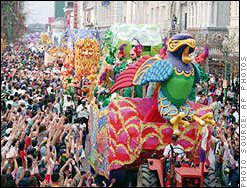Mardi Gras

The feast before the fast
 Millions of people every year crowd New Orleans to view the Mardi Gras parades. RELATED LINKSTest your Mardi Gras trivia skills.Take the Mardi Gras Quiz. Mardi Gras Dates:2015 Feb. 17 2016 Feb. 9 2017 Feb. 28 2018 Feb. 13 |
"Mardi Gras" means "Fat Tuesday." Traditionally, it is the last day for Catholics to indulge—and often overindulge—before Ash Wednesday starts the sober weeks of fasting that come with Lent. Formally known as Shrove Tuesday, Mardi Gras has long been a time of extravagant fun for European Christians.
In the United States, Mardi Gras draws millions of fun-seekers to New Orleans every year. Mardi Gras has been celebrated in New Orleans on a grand scale, with masked balls and colorful parades, since French settlers arrived in the early 1700s. Hidden behind masks, people behaved so raucously that for decades in the early 19th century masks were deemed illegal in that party-loving city.
Masks, Music, and Mayhem
French royals, feather-covered showgirls, Energizer bunnies, painted clowns, masked lions—you can find them all (and countless others) in the streets of New Orleans at Mardi Gras. By dawn on that most famous Tuesday, people have claimed the best spots on the streets to watch fabulous floats, outrageous performers, and visiting celebrities go by. Many travel hundreds of miles to be a part of the excitement.
Marching bands, some of them founded more than a century ago, also take to the streets with music and festive dress. They open the day by spreading jazz music through the city before the more than 350 floats and 15,000 costumed paraders take over the scene. Crazy costumes and wild make-up are the order of the day for paraders and parade-watchers alike.
Krewes: New Orleans Royalty
Mardi Gras has long combined wild street activities open to everyone with events organized by private clubs known as krewes. Today, thousands of people belong to about 60 krewes that plan the parades and balls of New Orleans' Mardi Gras. The oldest krewe, the Krewe of Comus, was founded in 1857 by men who feared the outrageous antics of Mardi Gras would lead to the holiday being outlawed. They hoped that secret societies could keep the celebrations alive. The Krewe of Comus withdrew from the parade schedule in 1992 when it refused to sign an ordinance prohibiting racial discrimination.
In 1872 the Russian grand duke Alexis Romanoff visited New Orleans at Mardi Gras. A group of businessmen organized the Krewe of Rex to host a parade for the occasion, and appointed a "king for the day" so that the grand duke could have a royal reception. Naming kings and queens at Mardi Gras balls has been a tradition of the krewes ever since. Another tradition began with that royal visit: the Romanoff house colors—purple for justice, green for faith, and gold for power—became the official colors of Mardi Gras.
Catch as Catch Can
The millions of colorful beaded necklaces thrown from floats are the most visible symbols and souvenirs of Mardi Gras. In addition, millions of cups and toy coins known as "doubloons" are decorated with krewe logos and thrown to parade-watchers. Some "throws" are especially prized: only the luckiest folks manage to take home the hand-decorated coconuts from the Krewe of Zulu.
People do outrageous things to catch the most throws. Some dress as priests, hoping the many Catholics on the floats will shower them with goodies. Others dress their children in eye-catching costumes and seat them, holding baskets to catch the loot, on ladders that tower over the crowds.
After Katrina
Hurricane Katrina slammed into New Orleans at the end of August 2005, but within a few months the city decided that Mardi Gras would go on. Many of the krewes had safely stored their parade floats before the hurricane. Some of the most popular parade routes, including St. Charles and Magazine Streets, were spared in the storm. For after-parade decadence, the French Quarter also emerged relatively unscathed.
